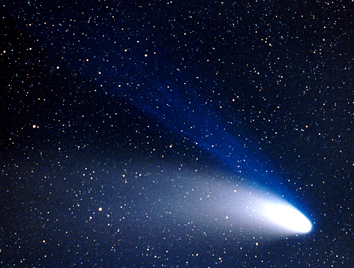Cometary Dust Tail
The dust tail is the most visually spectacular part of the comets we occasionally see in the night sky. Reaching typical lengths of tens of millions of kilometres, they are composed primarily of smoke-sized dust particles with an average diameter of around a micrometre, and are yellow in colour as they shine by reflected sunlight.
The dust tail of a comet starts to form somewhere around the orbit of Mars. Here, the Sun begins to heat the nucleus of the comet releasing gas and dust into a temporary atmosphere called the coma. When sunlight strikes the dust particles in the coma, it exerts a pressure (called radiation pressure) which pushes the dust particles from the coma and into a dust tail. Since each dust particle has a different size, it ends up with a unique velocity in an individual orbit around the Sun, resulting in the broad dust tail.
This tail points away from the Sun, but because the dust particles are driven out of the coma more slowly than the ions making up the gas tail, they retain more of their original forward motion and the dust tail tends to be more curved than the gas tail.
Although all the dust in the tail of a comet is composed of smoke-sized grains, large grains can also be sheared off the nucleus. Instead of joining the dust tail, these grains form a meteor stream which continues to orbit the Sun in the same path as the comet. If the Earth intersects this stream during its orbit, we see a meteor shower.
Study Astronomy Online at Swinburne University
All material is © Swinburne University of Technology except where indicated.


